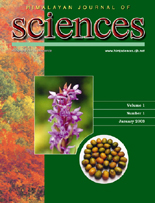Domesticating Lapsi, <i>Choerospondias axillaris Roxb.</i> (B. L. Burtt & A. W. Hill) for fruit production
DOI:
https://doi.org/10.3126/hjs.v1i1.188Keywords:
Lapsi, Choerospondias axillaris Roxb.Abstract
Cherospondias axillaris is a potential agroforestry tree species for income generation and nutrient supplementation in the middle mountains of rural Nepal. The occurrence and distribution of C. axillaris (locally known as Lapsi in Nepal) has been surveyed and documented. Status of indigenous knowledge about cultivation, management and utilisation has been studied and documented; indigenous indicators for early sex determination and criteria for fruit quality assessment has been established. Based on farmers selection and fruit quality assessment, elite trees for quality fruit production has been selected and methods for their successful propagation has been developed. Lapsi was reported growing in 301 Village Development Committees of 29 hill districts. Over 40000 trees has been producing fruits and additional 500,000 new trees has been planted. Interest on lapsi cultivation and marketing is increasing. Farmers have wealth of indigenous knowledge on lapsi ecology, husbandry practices and variation in different lapsi types. This knowledge combined with scientific methods has offered better opportunities for lapsi domestication. Bud grafting, side grafting, hardwood and softwood cutting propagation were successful methods for lapsi propagation, while research in tissue culture is still underway. Bud grafting during the first three weeks in February is recommended for lower cost and effectiveness (90% success). Selected trees are recommended for mass propagation and planting for quality fruit production. Himalayan Journal of Sciences 1(1): 55-58, 2003Downloads
Download data is not yet available.
Abstract
1550
PDF
4250
Downloads
How to Cite
Poudel, K. C. (2006). Domesticating Lapsi, <i>Choerospondias axillaris Roxb.</i> (B. L. Burtt & A. W. Hill) for fruit production. Himalayan Journal of Sciences, 1(1), 55–58. https://doi.org/10.3126/hjs.v1i1.188
Issue
Section
Articles




